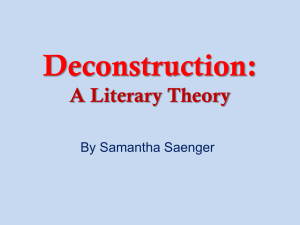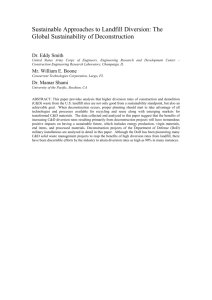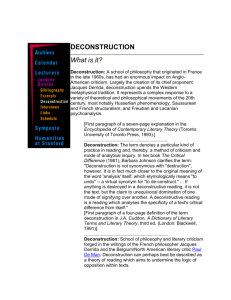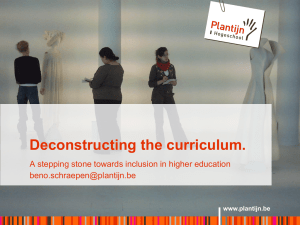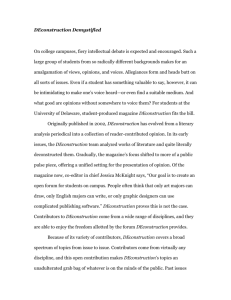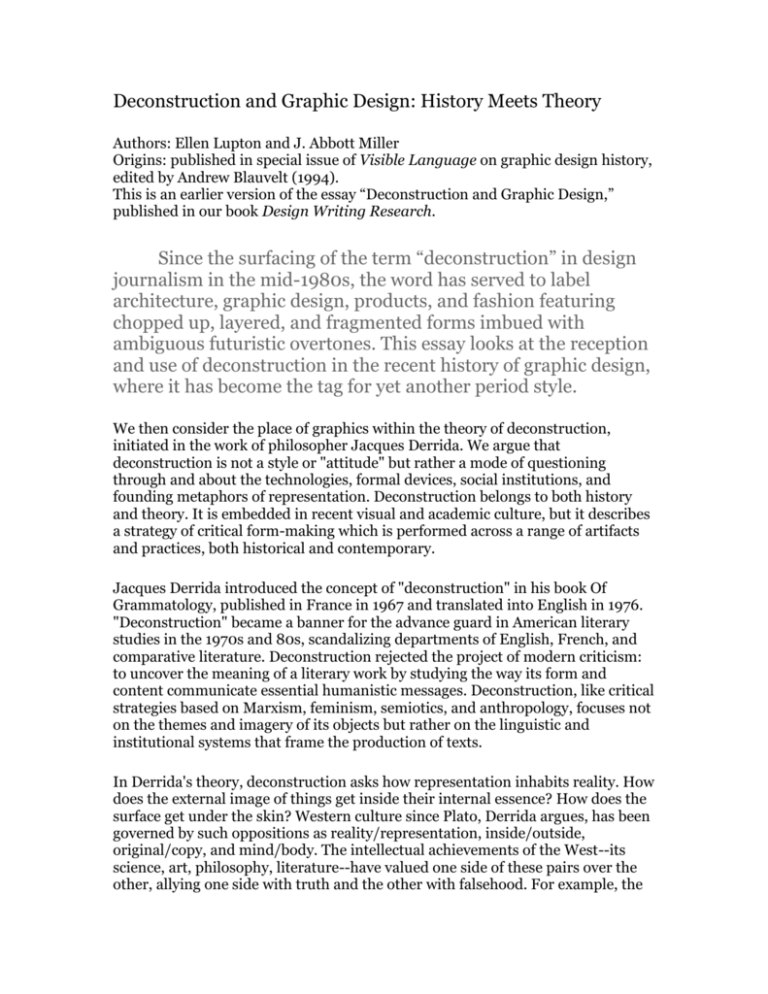
Deconstruction and Graphic Design: History Meets Theory
Authors: Ellen Lupton and J. Abbott Miller
Origins: published in special issue of Visible Language on graphic design history,
edited by Andrew Blauvelt (1994).
This is an earlier version of the essay “Deconstruction and Graphic Design,”
published in our book Design Writing Research.
Since the surfacing of the term “deconstruction” in design
journalism in the mid-1980s, the word has served to label
architecture, graphic design, products, and fashion featuring
chopped up, layered, and fragmented forms imbued with
ambiguous futuristic overtones. This essay looks at the reception
and use of deconstruction in the recent history of graphic design,
where it has become the tag for yet another period style.
We then consider the place of graphics within the theory of deconstruction,
initiated in the work of philosopher Jacques Derrida. We argue that
deconstruction is not a style or "attitude" but rather a mode of questioning
through and about the technologies, formal devices, social institutions, and
founding metaphors of representation. Deconstruction belongs to both history
and theory. It is embedded in recent visual and academic culture, but it describes
a strategy of critical form-making which is performed across a range of artifacts
and practices, both historical and contemporary.
Jacques Derrida introduced the concept of "deconstruction" in his book Of
Grammatology, published in France in 1967 and translated into English in 1976.
"Deconstruction" became a banner for the advance guard in American literary
studies in the 1970s and 80s, scandalizing departments of English, French, and
comparative literature. Deconstruction rejected the project of modern criticism:
to uncover the meaning of a literary work by studying the way its form and
content communicate essential humanistic messages. Deconstruction, like critical
strategies based on Marxism, feminism, semiotics, and anthropology, focuses not
on the themes and imagery of its objects but rather on the linguistic and
institutional systems that frame the production of texts.
In Derrida's theory, deconstruction asks how representation inhabits reality. How
does the external image of things get inside their internal essence? How does the
surface get under the skin? Western culture since Plato, Derrida argues, has been
governed by such oppositions as reality/representation, inside/outside,
original/copy, and mind/body. The intellectual achievements of the West--its
science, art, philosophy, literature--have valued one side of these pairs over the
other, allying one side with truth and the other with falsehood. For example, the
Judeo-Christian tradition has conceived the body as an external shell for the
inner soul, elevating the mind as the sacred source of thought and spirit, while
denigrating the body as mere mechanics. In the realm of aesthetics, the original
work of art traditionally has carried an aura of authenticity that its copy lacks,
and the telling of a story or the taking of a photograph is viewed as a passive
record of events.
"Deconstruction" takes apart such oppositions by showing how the devalued,
empty concept lives inside the valued, positive one. The outside inhabits the
inside. Consider, for example, the opposition between nature and culture. The
idea of "nature" depends on the idea of "culture," and yet culture is part of nature.
It's a fantasy to conceive of the non-human environment as a pristine, innocent
setting fenced off and protected from the products of human endeavor--cities,
roads, farms, landfills. The fact that we have produced a concept of "nature" in
opposition to "culture" is a symptom of our alienation from the ecological
systems that civilization depletes and transforms.
A crucial opposition for deconstruction is speech/writing. The Western
philosophical tradition has denigrated writing as an inferior copy of the spoken
word. Speech draws on interior consciousness, but writing is dead and abstract.
The written word loses its connection to the inner self. Language is set adrift,
untethered from the speaking subject. In the process of embodying language,
writing steals its soul. Deconstruction views writing as an active rather than
passive form of representation. Writing is not merely a bad copy, a faulty
transcription, of the spoken word; writing, in fact, invades thought and speech,
transforming the sacred realms of memory, knowledge, and spirit. Any memory
system, in fact, is a form of writing, since it records thought for the purpose of
future transmissions.
The speech/writing opposition can be mapped onto a series of ideologically
loaded pairs that are constitutive of modern Western culture:
Speech/Writing
Natural/artificial
Spontaneous/constructed
Original/copy
interior to the mind/exterior to the mind
requires no equipment/requires equipment
intuitive/learned
present subject/absent subject
Derrida's critique of the speech/writing opposition locates the concerns of
deconstruction in the field of graphic design. We will return to the speech/writing
problem in more detail later, but first, we will look at the life of deconstruction in
recent design culture.
The Design History of Deconstruction
Deconstruction belongs to the broader critical field known as "poststructuralism," whose key figures include Roland Barthes, Michel Foucault, Jean
Baudrillard, and others. Each of these writers has looked at modes of
representation--from literature and photography to the design of schools and
prisons--as powerful technologies which build and remake the social world.
Deconstruction's attack on the neutrality of signs is also at work in the consumer
mythologies of Barthes, the institutional archaeologies of Foucault, and the
simulationist aesthetics of Baudrillard.
The idea that cultural forms help to fabricate such seemingly "natural" categories
as race, sexuality, poetic genius, and aesthetic value had profound relevance to
visual artists in the 1980s. Post-structuralism provided a critical avenue into
"post-modernism," posing a left-leaning alternative to the period's nostalgic
returns to figurative painting and neo-classical architecture. While Barbara
Kruger, Cindy Sherman, and Victor Burgin attacked media myths through their
visual work, books such as Hal Foster's The Anti-Aesthetic and Terry Eagleton's
Literary Theory delivered post-structuralist theory to students in an accessible
form.
Graphic designers in many U. S. art programs were exposed to critical theory
through the fields of photography, performance and installation art during the
early 1980s. The most widely publicized intersection of post-structuralism and
graphic design occurred at the Cranbrook Academy of Art, under the leadership
of co-chair Katherine McCoy. Designers at Cranbrook had first confronted
literary criticism when they designed a special issue of Visible Language on
contemporary French literary aesthetics, published in the summer of 1978.
Daniel Libeskind, head of Cranbrook's architecture program, provided the
graphic designers with a seminar in literary theory, which prepared them to
develop their strategy: to systematically disintegrate the the series of essays by
expanding the spaces between lines and words and pushing the footnotes into the
space normally reserved for the main text. French Currents of the Letter, which
outraged designers committed to the established ideologies of problem-solving
and direct communication, remains a controversial landmark in experimental
graphic design.
According to Katherine McCoy, post-structuralist texts entered more general
discussions at Cranbrook around 1983. She has credited Jeffery Keedy, a student
at the school from 1983-85, with introducing fellow course members to books by
Barthes and others. The classes of 1985/87 and 1986/88 also took an active
interest in critical theory; students at this time included Andrew Blauvelt, Brad
Collins, Edward Fella, David Frej, and Allen Hori. Close interaction with the
photography department, under the leadership of Carl Toth, further promoted
dialogue about post-structuralism and visual practice.
Post-structuralism did not serve as a unified methodology at the school, however,
even in the period of its strongest currency, but was part of an eclectic gathering
of ideas. According to Keedy, students at Cranbrook when he was there were
looking at everything from alchemical mysticism to the "proportion voodoo" of
the golden section. McCoy recalled in a 1991 interview: "Theory had become part
of the intellectual culture in art and photography. We were never trying to apply
specific texts--it was more of a general filtration process. The term
'deconstructivist' drives me crazy. Post-structuralism is an attitude, not a style."
But what is the difference between "style" and "attitude"? If "style" is a grammar
of form-making associated with a particular historical and cultural situation, then
perhaps "attitude" is the unarticulated, just out-of-focus background for the
specificities of style.
The response to post-structuralism at Cranbrook was largely optimistic, sidestepping the profound pessimism and political critique that permeates these
writers' major works. McCoy used the architectural theory of Robert Venturi and
Denise Scott Brown as a "stepping stone" to post-structuralism, enabling her to
merge the Pop aestheticization of the American commercial vernacular with poststructuralism's critique of "fixed meaning." McCoy's preference for celebration
over criticism is echoed in Keedy's comment, "It was the poetic aspect of Barthes
which attracted me, not the Marxist analysis. After all, we're designers working in
a consumer society, and while Marxism is interesting as an idea, I wouldn't want
to put it into practice."
Post-structuralism's emphasis on the openness of meaning has been incorporated
by many designers into a romantic theory of self-expression: as the argument
goes, because signification is not fixed in material forms, designers and readers
share in the spontaneous creation of meaning. This approach represents a rather
cheerful response to the post-structuralist theme of the "death of the author" and
the assertion that the interior self is constructed by external technologies of
representation. According to the writings of Barthes and Foucault, for example,
the citizen/artist/producer is not the imperious master of systems of language,
media, education, custom, and so forth; instead, the individual operates within
the limited grid of possibilities these codes make available. Rather than view
meaning as a matter of private interpretation, post-structuralist theory tends to
see the realm of the "personal" as structured by external signs. Invention and
revolution come from tactical aggressions against this grid of possibilities.
"Deconstructivism" catapulted into the mainstream design press with MoMA's
1988 exhibition Deconstructivist Architecture, curated by Philip Johnson and
Mark Wigley. The curators used the term "deconstructivism" to link certain
contemporary architectural practices to Russian Constructivism, whose early
years were marked by an imperfect vision of form and technology. The MoMA
exhibition located a similarly skewed interpretation of modernism in the work of
Frank Gehry, Daniel Libeskind, Peter Eisenman, and others. Wigley wrote in his
catalogue essay: "A deconstructive architect is...not one who dismantles
buildings, but one who locates the inherent dilemmas within buildings. The
deconstructive architect puts the pure forms of the architectural tradition on the
couch and identifies the symptoms of a repressed impurity. The impurity is
drawn to the surface by a combination of gentle coaxing and violent torture: the
form is interrogated" (11). In Wigley's view, deconstruction in architecture asks
questions about modernism by re-examining its own language, materials, and
processes.
By framing their exhibition around a new "ism," Wigley and Johnson helped to
canonize the elements of a period style, marked by twisted geometries, centerless
plans, and shards of glass and metal. This cluster of stylistic features quickly
emigrated from architecture to graphic design, just as the icons and colors of neoclassical post-modernism had traveled there shortly before. While a more critical
approach to deconstruction had been routed to graphic designers through the
fields of photography and the fine arts, architecture provided a ready-to-use
formal vocabulary that could be broadly adopted. "Deconstruction,"
"deconstructivism," and just plain "decon" became design-world clichés, where
they named existing tendencies and catalyzed new ones in the fields of furniture
and fashion as well as graphic design.
In 1990 Philip Meggs published a how-to guide for would-be deconstructivists in
the magazine Step-by-Step Graphics. His essay, which includes a journalistic
account of how the term "deconstruction" entered the field of graphic design,
focuses on style and works back to theory. Following the logic of the MoMA
project, his story begins with Constructivism and ends with its "deconstruction"
in contemporary design; unlike Wigley, however, Meggs's story depicts early
modernism as a purely rational enterprise.
Chuck Byrne and Martha Witte©ˆs more analytical piece for Print (1990)
describes deconstruction as a "zeitgeist," a philosophical germ circulating in
contemporary culture that influences graphic designers even though they might
not know it. Their view corresponds roughly to McCoy's sense of poststructuralism as a general "attitude" or "filtration process" responding to the
"intellectual culture" of the time. Byrne and Witte's article identifies examples of
deconstruction across the ideological map of contemporary design, ranging from
the work of Paula Scher and Stephen Doyle to Lucille Tenazas and Lorraine Wild.
In the mid-90s, the term "deconstruction" was used casually to label any work
that favors complexity over simplicity and dramatizes the formal possibilities of
digital production--the term is commonly used to invoke a generic allegiance with
"Cranbrook" or "CalArts," a gesture which reduces both schools to flat symbols by
blanketing a variety of distinct practices. Our view of deconstruction in graphic
design is at once narrower and broader in its scope than the view evolving from
the current discourse. Rather than look at deconstruction as a historical style or
period, we see deconstruction as a critical activity--an act of
questioning. The visual resources of typography help demarcate Derrida's
ideological map of the biases governing Western art and philosophy. Having
looked at deconstruction's life in recent design culture, we will now locate design
within the theory of deconstruction.
Design in Deconstruction
Derrida's critique of the speech/writing opposition developed out of his reading
of Ferdinand de Saussure's Course in General Linguistics, a foundational text for
modern linguistics, semiotics, and anthropology. Saussure asserted that the
meaning of signs does not reside in the signs themselves: there is no natural bond
between the signifier (the sign's material aspect) and the signified (its referent).
Instead, the meaning of a sign comes only from its relationship to other signs in a
system. This principle is the basis of structuralism, an approach to language
which focuses on the patterns or structures that generate meaning rather than on
the "content" of a given code or custom.
Saussure revealed that because the sign has no inherent meaning, it is, taken by
itself, empty, void, absent. The sign has no life apart from the system or
"structure" of language. Saussure revealed that language is not a transparent
window onto pre-existing concepts, but that language actively forms the realm of
ideas. The base, material body of the signifier is not a secondary copy of the
elevated, lofty realm of concepts: both are formless masses before the articulating
work of language has sliced it into distinct pieces. Instead of thinking of language
as a code for passively representing "thoughts," Saussure showed that "thoughts"
take shape out of the material body of language.
Derrida's Of Grammatology points out that although Saussure was willing to
reveal the emptiness at the heart of language, he became infuriated when he saw
the same principle at work in writing, the system of signs created to represent
speech. Saussure's text views writing as a copy of speech, an artificial technology
for reproducing language. While the alphabet claims to be a phonetic
transcription of spoken sounds, codes such as written English are full of
irrational spellings: for example, words that sound the same but are spelled
differently (meet/meat), and letter combinations with unexpected pronunciations
(th-, sh-, -ght). The tone of Saussure's critique escalates from mild irritation at
the beginning of his presentation to impassioned condemnation of the alphabet's
violation of an innocent, natural speech: "writing obscures language; it is not a
guise for language but a disguise." The "tyranny of writing" distorts its pristine
referent through "orthographic monstrosities" and "phonic deformations" (30-2).
Saussure specifically concerned himself with phonetic writing, the paradigmatic
medium of Western culture, which translates the diverse sounds of a language
into a set of repeatable graphic marks. He explicitly excluded pictographic and
ideographic scripts from his attack on writing; Chinese ideograms have fewer
"annoying consequences" than the alphabet, because their users clearly
understand their role as secondary signs for spoken words (26). The power (and
seductiveness) of phonetic writing lies in its economy: a small number of
characters can represent an ever-expanding quantity of words. Unlike
pictographic or ideographic scripts, phonetic writing represents the signifier of
language (its material sound) rather than the signified (its conceptual meaning or
"idea"). Whereas an ideogram represents the concept of a word, phonetic
characters merely represent its sounds. The alphabet thus embraces the
arbitrariness of the sign by considering the signifier independently of its
meaning.
As an intellectual technology, alphabetic writing can be compared to
photography: it is an automatic record of the surface of language. The alphabet
cleaved language into an inside and an outside: the destiny of phonetic writing is
to occupy the outside, to be a mechanical copy of the signifier, leaving intact a
sacred interior. The belief in the interiority, the fullness, of speech depends on
the existence of an exterior, empty representation--the alphabet. Similarly, the
notion of "nature," as an ideal realm separate from human production, emerged
as "civilization" was despoiling the broader ecological systems in which culture
participates. To "deconstruct" the relationship between speech and writing is to
reverse the status of the two terms, but not just to replace one with the other, but
rather to show that speech was always already characterized by the same failure
to transparently reflect reality. There is no innocent speech.
In Of Grammatology, Derrida asserted that an intellectual culture (or episteme)
built on the opposition between reality and representation has, in fact, depended
on representations to construct itself: "External/internal, image/reality,
representation/presence, such is the old grid to which is given the task of
outlining the domain of a science. And of what science? Of a science that can no
longer answer to the classical concept of the episteme because the originality of
its field--an originality that it inaugurates--is that the opening of the 'image'
within it appears as the condition of 'reality,' a relationship that can no longer be
thought within the simple difference and the uncompromising exteriority of
'image' and 'reality,' of 'outside' and 'inside,' of 'appearance' and 'essence' (33)."
The fact that our culture developed a phonetic writing system--one which
represents the material signifier in isolation from the sacred signified--is
indicative of our primary alienation from the spoken language. Phonetic writing,
because it makes use of the gap between signifier and signified, is not simply a
secondary reflection of language, but is a symptom of language's lack of presence,
its lack of interior self-completeness.
Derrida's final attack on the notion of writing as a secondary copy of speech is to
make the claim that "phonetic writing does not exist" (39). Not only does writing
inhabit speech, transforming its grammar and sound, and not only does phonetic
writing exist as language's "own other," an "outside" manufactured to affirm its
own complete "insidedness," but this model of the "outside" continually fails to
behave in the manner expected of it. Thus where Saussure had claimed that there
are only two kinds of writing--phonetic and ideographic--Derrida found the
frontiers between them to fluctuate.
Phonetic writing is full of non-phonetic elements and functions. Some signs used
in conjunction with the alphabet are ideographic, including numbers and
mathematical symbols. Other graphic marks cannot be called signs at all, because
they do not represent distinct "signifieds" or concepts: for example, punctuation,
flourishes, deletions, and patterns of difference such as roman/italic and
uppercase/lowercase. What "idea" does the space between two words or a
dingbat at the end of a line represent? Key among these marks, which Derrida
has called "graphemes," are various forms of spacing--negative gaps between the
positive symbols of the alphabet. Spacing cannot be dismissed as a "simple
accessory" of writing: "That a speech supposedly alive can lend itself to spacing in
its own writing is what relates to its own death" (39). The alphabet has come to
rely on silent graphic servants such as spacing and punctuation, which, like the
frame of a picture, seem safely "outside" the proper content and internal
structure of a work and yet are necessary conditions for making and reading.
Derrida's book The Truth in Painting unfolds the logic of framing as a crucial
component of works of art. In the Enlightenment aesthetics of Kant, which form
the basis for modern art theory and criticism, the frame of a picture belongs to a
class of elements called parerga, meaning "about the work," or outside/around
the work. Kant's parerga include the columns on buildings, the draperies on
statues, and the frames on pictures. A frame is an ornamental appendix to a work
of art, whose "quasi-detachment" serves not only to hide but also to reveal the
emptiness at the core of the seemingly self-complete object of aesthetic pleasure.
In Derrida's words, "The parergon is a form that has, as its traditonal
determination, not that it stands out but that it disappears, buries itself, effaces
itself, melts away at the moment it deploys its greatest energy. The frame is in no
way a background....but neither is its thickness as margin a figure. Or at least it is
a figure which comes away of its own accord" (61). Like the non-phonetic
supplements to the alphabet, the borders around pictures or texts occupy an
ambiguous place between figure and ground, positive element and negative gap.
Spacing and punctuation, borders and frames: these are the territory of graphic
design and typography, those marginal arts which articulate the conditions that
make texts and images readable. The substance of typography lies not in the
alphabet per se--the generic forms of characters and their conventionalized uses-but rather in the visual framework and specific graphic forms which materialize
the system of writing. Design and typography work at the edges of writing,
determining the shape and style of letters, the spaces between them, and their
positions on the page. Typography, from its position in the margins of
communication, has moved writing away from speech.
Design as Deconstruction
The history of typography and writing could be written as the development of
formal structures which have articulated and explored the border between the
inside and the outside of the text. To compile a catalogue of the micro-mechanics
of publishing--indexes and title pages, captions and colophons, folios and
footnotes, leading and line lengths, margins and marginalia, spacing and
punctuation--would contribute to the field which Derrida has called
grammatology, or the study of writing as a distinctive mode of representation.
This word, grammatology, serves to title the book whose more infamous legacy is
deconstruction.
Such a history could position various typographic techniques in relation to the
split between form and content, inside and outside. Some typographic
conventions have served to rationalize the delivery of information by erecting
transparent "crystal goblets" around a seemingly independent, neutral body of
"content." Some structures or approaches invade the sacred interior so deeply as
to turn the text inside out, while others deliberately ignore or contradict the
internal organization of a text in response to external pressures imposed by
technology, aesthetics, corporate interests, social propriety, production
conveniences, etc.
Robin Kinross's Modern Typography (1992) charts the progressive
rationalization of the forms and uses of letters across several centuries of
European history. Kinross's book characterizes printing as a prototypically
"modern" process, that from its inception mobilized techniques of mass
production and precipitated the mature arts and sciences. The seeds of
modernization were present in Gutenberg's first proofs; their fruits are born in
the self-conscious methodologies, professionalized practices, and standardized
visual forms of printers and typographers, which, beginning in the late
seventeenth century, replaced an older notion of printing as a hermetic art of
"black magic," its methods jealously guarded by a caste of craftsmen.
If Kinross's history of modern typography spans five centuries, so too might
another history of deconstruction, running alongside and beneath the erection of
transparent formal structures and coherent bodies of professional knowledge.
Derrida's own writing has drawn on forms of page layout from outside the
accepted conventions of university publishing. His book Glas, designed with
Richard Eckersley at the University of Nebraska Press, consists of parallel texts
set in different typefaces and written in heterogeneous voices. Glas makes the
scholarly annotations of medieval manuscripts and the accidental juxtapositions
of modern newspapers part of a deliberate authorial strategy.
A study of typography and writing informed by deconstruction would reveal a
range of structures that dramatize the intrusion of visual form into verbal
content, the invasion of "ideas" by graphic marks, gaps, and differences. Figures 6
and 7, pages of late fifteenth-century book typography, represent two different
attitudes towards framing the text. In the first, the margins are a transparent
border for the solid block dominating the page. The lines of classical roman
characters are minimally interrupted--paragraph breaks are indicated only by a
wider gap within the line, preserving the text as a continuously flowing field of
letters. The second example draws on the tradition of scribal marginalia and
biblical commentary. Here, typography is an interpretive medium; the text is
open rather than closed. The first example suggests that the frontiers between
interior and exterior, figure and ground, reader and writer, are securely defined,
while the second example dramatizes such divides by engulfing the center with
the edge.
Another comparison comes from the history of the newspaper, which emerged as
an elite literary medium in the seventeenth century. Early English newspapers
based their structure on the classical book, whose consistently formatted text
block was designed to be read from beginning to end. As the newspaper became a
popular medium in nineteenth-century Europe and America, it expanded from a
book-scaled signature to a broadsheet incorporating diverse elements, from
reports of war and crime to announcements of ship departures and ads for goods
and services. The modern illustrated newspaper of the twentieth century is a
patchwork of competing elements, whose juxtaposition responds not to rational
hierarchies of content but to the struggle between editorial, advertising, and
production interests. While the structure of the classical news journal aspired to
the status of a coherent, complete object, the appearance of the popular paper
results from frantic compromises and arbitrary conditions; typographic design
serves to distract and seduce as well as to clarify and explain.
Dictionaries of page design featuring schematic diagrams of typical layouts have
been a common theme in twentieth-century design. Such visual enactments of
theory include Jan Tschichold's 1934 manifesto "The Placing of Type in a Given
Space," which charts a range of subtle variations in the placement of headings
and body copy, and Don May's 1942 manual 101 Roughs, which catalogues
various types of commercial page design. While Tschichold charted minor
differences between clearly ordered elements, May accommodated the diverse
media and competing messages found in advertising. Both theorists presented a
series of formal containers for abstract, unspecified bodies of "content, " but with
a difference: Tschichold©ˆs structures are neutral frames for dominant textual
figures, while May©ˆs patterns are active grounds which ignore conventional
hierarchies in favor of such arbitrary rules as "Four point: The layout touches all
four sides of the space once and only once" [Figure 8], or "Center axis: The
heading copy, illustration, and logotype flush on alternate sides of axis."
If one pursued the study of "grammatology" proposed by Derrida, the resulting
catalogue of forms might include the graphic conditions outlined above. In each
case, we have juxtaposed a coherent, seemingly self-complete literary artifact
with a situation where external forces aggressively interfere with the sacred
interior of content. A history of typography informed by deconstruction would
show how graphic design has revealed, challenged, or transformed the accepted
rules of communication. Such interventions can represent either deliberate
confrontations or haphazard encounters with the social, technological, and
aesthetic pressures that shape the making of texts.
In a 1994 interview in The New York Times Magazine, Derrida was asked about
the purported "death" of deconstruction on North American campuses; he
answered, "I think there is some element in deconstruction that belongs to the
structure of history or events. It started before the academic phenomenon of
deconstruction, and it will continue with other names." In the spirit of this
statement, we are interested in de-periodizing the relevance of deconstruction:
instead of viewing it as an "ism" of the late-80s and early-90s, we see it as part of
the ongoing development of design and typography as distinctive modes of
representation. But deconstruction also belongs to culture: it is an operation that
has taken a name and has spun a web of influence in particular social contexts.
Deconstruction has lived in a variety of institutional worlds, from university
literature departments to schools of art and design to the discourse of popular
journalism, where it has functioned both as a critical activity and as a banner for
a range of styles and attitudes. We will close our essay with two examples of
graphic design that actively engage the language of contemporary media: the first
confronts the politics of representation, while the second remakes design's
internal language.
Vincent Gagliostro's cover for NYQ [Figure 10], a gay and lesbian news magazine,
was designed in November, 1991, in response to Magic Johnson's announcement
that he is HIV+. Gagliostro imposed NYQ's own logo and headline over a
Newsweek cover featuring Magic Johnson proclaiming "Even me," his upheld
arms invoking saintly sacrifice and athletic vigor. "He is not our hero," wrote
NYQ over the existing cover. While Gagliostro's layering and splicing of type and
image are shared with more aestheticized, individualized gestures found
elsewhere in contemporary design, this cover does not aim to trigger an infinite
variety of "personal" interpretations but instead explicitly manipulates an
ideologically loaded artifact. Gagliostro's act of cultural rewriting is a powerful
response to the ubiquity of normative sign systems, showing that the structures
of mass media can be reshuffled and reinhabited. The NYQ cover reveals and
exploits the function of framing as a transformative process that refuses to
remain outside the editorial content it encloses.
The manipulation of existing media imagery is one activity in contemporary
design that can be described as deconstruction; another is the exploration of the
visual grammar of communication, from print to the electronic interface.
Designers working in hypermedia are developing new ways to
generate, distribute, and use information--they are reinventing the
language of graphic design today, just as typographers reacted to the
changing technologies and social functions of printed media in the past. A leading
pioneer of this research was Muriel Cooper, who founded the Visible Language
Workshop at MIT in 197X. In the wake of her death in the spring of 1994, her
students are continuing to build a concrete grammar of three-dimensional,
dynamic typography. Cooper called the basic elements of this language
"geometric primitives," defined by relationships of size, brightness, color,
transparency, and location in 3-D space, variables which can shift in response to
the user©ˆs position in a document. Cooper and her students have worked to
restructure the internal language of typography in four dimensions.
Spacing, framing, punctuation, type style, layout, and other nonphonetic marks
of difference constitute the material interface of writing. Traditional literary and
linguistic research overlook such graphic structures, focusing instead on the
Word as the center of communication. According to Derrida, the functions of
repetition, quotation, and fragmentation that characterize writing are conditions
endemic to all human expression--even the seemingly spontaneous, self-present
utterances of speech or the smooth, naturalistic surfaces of painting and
photography. Design can critically engage the mechanics of representation,
exposing and revising its ideological biases; design also can remake the grammar
of communication by discovering structures and patterns within the material
media of visual and verbal writing.
Some Rights Reserved. This work is licensed under a Creative Commons License. Ellen Lupton,
2004.


